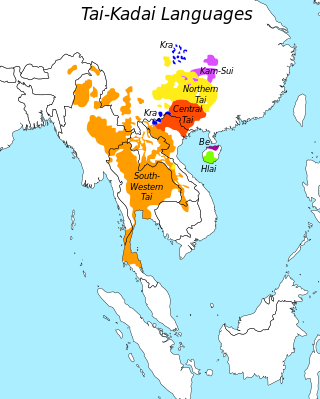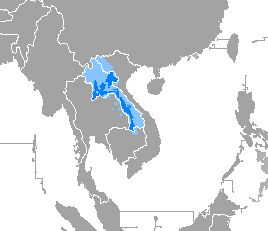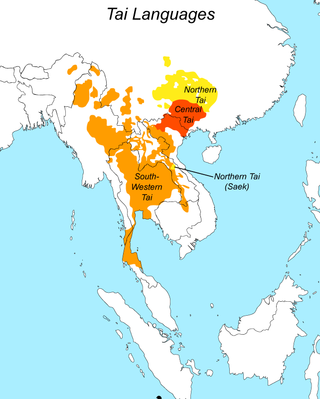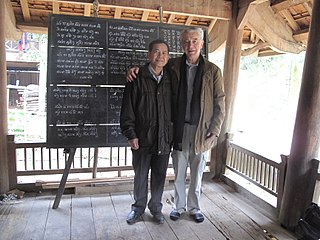
The Kra–Dai languages, are a language family in mainland Southeast Asia, southern China, and northeastern India. All languages in the family are tonal, including Thai and Lao, the national languages of Thailand and Laos, respectively. Around 93 million people speak Kra–Dai languages; 60% of those speak Thai. Ethnologue lists 95 languages in the family, with 62 of these being in the Tai branch.

Lao, sometimes referred to as Laotian, is the official language of Laos and a significant language in the Isan region of northeastern Thailand, where it is usually referred to as the Isan language. Spoken by over 3 million people in Laos and 3.2 million in all countries, it serves as a vital link in the cultural and social fabric of these areas. It is written in the Lao script, an abugida that evolved from ancient Tai scripts.

The Mon are an ethnic group who inhabit Lower Myanmar's Mon State, Kayin State, Kayah State, Tanintharyi Region, Bago Region, the Irrawaddy Delta, and several areas in Thailand. The native language is Mon, which belongs to the Monic branch of the Austroasiatic language family and shares a common origin with the Nyah Kur language, which is spoken by the people of the same name that live in Northeastern Thailand. A number of languages in Mainland Southeast Asia are influenced by the Mon language, which is also in turn influenced by those languages.

The Tai, Zhuang–Tai, or Daic languages are a branch of the Kra–Dai language family. The Tai languages include the most widely spoken of the Tai–Kadai languages, including Standard Thai or Siamese, the national language of Thailand; Lao or Laotian, the national language of Laos; Myanmar's Shan language; and Zhuang, a major language in the Southwestern China's Guangxi Zhuang Autonomous Region, spoken by the Zhuang people (壯), the largest minority ethnic group in China, with a population of 15.55 million, living mainly in Guangxi, the rest scattered across Yunnan, Guangdong, Guizhou and Hunan provinces.
Saek is a Tai language spoken in at least ten villages in Khammouane Province, Laos, and at least four villages in Nakhon Phanom Province in northeastern Thailand, just across the Mekong River. It is spoken by the Saek people.
Southern Thai, also known as Dambro, Pak Tai, or "Southern language", is a Southwestern Tai ethnolinguistic identity and language spoken in southern Thailand, as well as by small communities in the northernmost states of Malaysia. It is spoken by roughly five million people and as a second language by the 1.5 million speakers of Pattani and other ethnic groups such as the local Peranakan communities, Negritos and other tribal groups. Most speakers are also fluent in or understand the Central Thai dialects.

The Vietic languages are a branch of the Austroasiatic language family, spoken by the Vietic peoples in Laos and Vietnam. The branch was once referred to by the terms Việt–Mường, Annamese–Muong, and Vietnamuong; the term Vietic was proposed by La Vaughn Hayes, who proposed to redefine Việt–Mường as referring to a sub-branch of Vietic containing only Vietnamese and Mường.
Mueang, Muang, Mong, Meng or Mường (Vietnamese) were pre-modern semi-independent city-states or principalities in mainland Southeast Asia, adjacent regions of Northeast India and Southern China, including what is now Thailand, Laos, Burma, Cambodia, parts of northern Vietnam, southern Yunnan, western Guangxi and Assam.

The Khamti language is a Southwestern Tai language spoken in Myanmar and India by the Khamti people. It is closely related to, and sometimes considered a dialect of, Shan.

Phuan or Northeastern Lao is a Tai language spoken in Laos, Thailand and Cambodia.

Thailand is home to 51 living indigenous languages and 24 living non-indigenous languages, with the majority of people speaking languages of the Southwestern Tai family, and the national language being Central Thai. Lao is spoken along the borders with the Lao PDR, Karen languages are spoken along the border with Myanmar, Khmer is spoken near Cambodia and Malay is spoken in the south near Malaysia. Sixty-two 'domestic' languages are officially recognized, and international languages spoken in Thailand, primarily by international workers, expatriates and business people, include Burmese, Karen, English, Chinese, Japanese, and Vietnamese, among others.

The Austro-Tai languages, sometimes also Austro-Thai languages, are a proposed language family that comprises the Austronesian languages and Kra–Dai languages.

Khün, or Tai Khün, also known as Kengtung tai, Kengtung Shan, is the language of the Tai Khün people of Kengtung, Shan State, Myanmar. It is also spoken in Chiang Rai Province, Thailand, and Yunnan Province, China.

William J. Gedney was an American linguist notable for his work on Thai and related Tai languages.
Proto-Tai is the reconstructed proto-language of all the Tai languages, including modern Lao, Shan, Tai Lü, Tai Dam, Ahom, Northern Thai, Standard Thai, Bouyei, and Zhuang. The Proto-Tai language is not directly attested by any surviving texts, but has been reconstructed using the comparative method.

Tai peoples are the populations who speak the Tai languages. There are a total of about 93 million people of Tai ancestry worldwide, with the largest ethnic groups being Dai, Thai, Isan, Tai Yai (Shan), Tai Lai (Shanni), Lao, Tai Ahom, Tai Kassay, and some Northern Thai peoples.

The Southwestern Tai or Thailanguages are a branch of the Tai languages of Southeast Asia. Its languages include Central Thai (Siamese), Northern Thai (Lanna), Lao, Shan and others.

Tai Yo, also known as Tai Mène and Nyaw, is a Tai language of Southeast Asia. It is closely related to Tai Pao of Vietnam, where it may have originated. It was once written in a unique script, the Tai Yo script, but that is no longer in use. The language is known regionally in Laos and Thailand as Tai Mène and Tai Nyaw and, in Vietnam as Tai Do and Tai Quy Chau. Superficially, Tai Yo appears to be a Southwestern Tai language but this is only because of centuries of language contact and it is properly classified with the Northern Tai languages. The Nyaw/Nyo spoken in central Thailand and western Cambodia is not the same as Tai Yo.

Michel Ferlus was a French linguist who specialized in the historical phonology of languages of Southeast Asia. In addition to phonological systems, he also studied writing systems, in particular the evolution of Indic scripts in Southeast Asia.

The Kuy are an indigenous ethnic group of mainland Southeast Asia. The native lands of the Kuy range from the southern Khorat Plateau in northeast Thailand east to the banks of the Mekong River in southern Laos and south to north central Cambodia. The Kuy are an ethnic minority in all three countries, where they live as "hill tribes" or Montagnards. Their language is classified as a Katuic language of the Mon-Khmer language family. The Thais, Lao, and Khmer traditionally recognize the Kuy as the aboriginal inhabitants of the region. The word kuy in the Kuy language means "people" or "human being"; alternate English spellings include Kui, Kuoy and Kuay, while forms similar to "Suay" or "Suei" are derived from the Thai/Lao exonyms meaning "those who pay tribute". The Kuy are known as skilled mahouts, or elephant trainers, and many Kuy villages are employed in finding, taming, and selling elephants.














